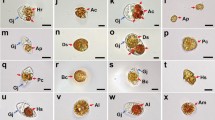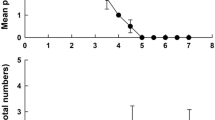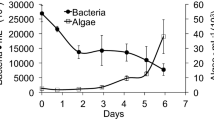Abstract
Predators influence the phenotype of prey through both natural selection and induction. We investigated the effects of grazers and nutrients on chain formation in a dinoflagellate, Cochlodinium polykrikoides, which forms dense blooms and has deleterious effects on marine ecosystems around the world. Field populations of C. polykrikoides formed longer chains than laboratory cultures without grazers. In the field, chain length of C. polykrikoides was positively correlated with the abundance of the copepod Acartia tonsa. Chain length of C. polykrikoides increased when exposed to live females of A. tonsa or its fresh (<24 h post-isolation) exudates for 48 h. These results suggest that dissolved chemical cues released by A. tonsa induce chain formation in C. polykrikoides. Ingestion rate of A. tonsa on four-cell chains of C. polykrikoides was lower than on single cells, suggesting that chain formation may be an effective anti-grazing defense. Finally, nutrient amendment experiments demonstrated that vitamins (B1, B7, and B12) increased the chain length of C. polykrikoides both singly and collectively, while trace metals and inorganic nutrients did not, showing that vitamins may also influence chain formation in this species.







Similar content being viewed by others
References
Agrawal AA (2001) Phenotypic plasticity in the interactions and evolution of species. Science 294:321–326
Båmstedt U, Gifford DJ, Irigoien X, Atkinson A, Roman M (2000) Feeding. In: Harris RP, Wiebe PH, Lenz J, Skjoldal HR, Huntley M (eds) ICES zooplankton methodology manual. Academic, New York, pp 297–399
Beardall J, Allen D, Bragg J, Finkel ZV, Flynn KJ, Quigg A, Rees TAV, Richardson A, Raven JA (2009) Allometry and stoichiometry of unicellular, colonial and multicellular phytoplankton. New Phytol 181:295–309
Berggreen U, Hansen B, Kiørboe T (1988) Food size spectra, ingestion and growth of the copepod Acartia tonsa during development: implications for determination of copepod production. Mar Biol 99:341–352
Berman T, Bronk DA (2003) Dissolved organic nitrogen: a dynamics participant in aquatic ecosystems. Aquat Microb Ecol 31:279–305
Brodie ED III, Brodie ED Jr (1999) Predator–prey arms races. Bioscience 49:557–568
Croft MT, Warren MJ, Smith AG (2006) Algae need their vitamins. Eukaryot Cell 5:1175–1183
Dutz J, Koski M, Jónasdóttir SH (2008) Copepod reproduction is unaffected by diatom aldehydes or lipid composition. Limnol Oceanogr 53:225–235
Fraga S, Gallager SM, Anderson DM (1989) Chain-forming dinoflagellates: an adaptation to red tides. In: Okaichi T, Anderson DM, Nemoto T (eds) Red tides: biology, environmental science, and toxicology. Elsevier, New York, pp 281–284
Gobler CJ, Norman C, Panzeca C, Taylor GT, Sañudo-Wilhelmy SA (2007) Effect of B-vitamins (B1, B12) and inorganic nutrients on algal bloom dynamics in a coastal ecosystem. Aquat Microb Ecol 49:181–194
Gobler CJ, Berry DL, Anderson OR, Burson A, Koch F, Rodgers BS, Moore LK, Goleski JA, Allam B, Bowser P, Tang Y, Nuzzi R (2008) Characterization, dynamics, and ecological impacts of harmful Cochlodinium polykrikoides blooms on eastern Long Island, NY, USA. Harmful Algae 7:293–307
Guillard RRL (1975) Culture of phytoplankton for feeding marine invertebrates. In: Smith WL, Chanley MH (eds) Culture of marine invertebrate animals. Plenum, NewYork, pp 22–60
Hay ME (2009) Marine chemical ecology: chemical signals and cues structure marine populations, communities, and ecosystems. Annu Rev Mar Sci 1:193–212
Hessen DO, Van Donk E (1993) Morphological changes in Scenedesmus induced by substances released from Daphnia. Arch Hydrobiol 127:129–140
Jiang X (2010) Ecological and evolutionary interactions between the copepod Acartia tonsa and the dinoflagellate Cochlodinium polykrikoides (Ph.D. dissertation). School of Marine and Atmospheric Sciences, Stony Brook University, Stony Brook
Jiang X, Tang Y, Lonsdale DJ, Gobler CJ (2009) Deleterious consequences of a red tide dinoflagellate Cochlodinium polykrikoides for the calanoid copepod Acartia tonsa Dana. Mar Ecol Prog Ser 390:105–116
Jiang X, Lonsdale DJ, Gobler CJ (2010) Density-dependent nutritional value of the dinoflagellate Cochlodinium polykrikoides to the copepod Acartia tonsa. Limnol Oceanogr 55:1643–1652
Kiørboe T, Andersen A, Langlois VJ, Jakobsen HH, Bohr T (2009) Mechanisms and feasibility of prey capture in ambush-feeding zooplankton. Proc Natl Acad Sci USA 106:12394–12399
Lampert W, Rothhaupt KO, Von Elert E (1994) Chemical induction of colony formation in a green alga (Scenedesmus acutus) by grazers (Daphnia). Limnol Oceanogr 39:1543–1550
Landsberg JH (2002) The effects of harmful algal blooms on aquatic organism. Rev Fish Sci 10:113–390
Lee DK (2008) Cochlodinium polykrikoides blooms and eco-physical conditions in the South Sea of Korea. Harmful Algae 7:318–323
Litchman E, Klausmeier CA (2008) Trait-based community ecology of phytoplankton. Annu Rev Ecol Evol Syst 39:615–639
Long JD, Smalley GW, Barsby T, Anderson JT, Hay ME (2007) Chemical cues induce consumer-specific defenses in a bloom-forming marine phytoplankton. Proc Natl Acad Sci USA 104:10512–10517
Lürling M (2003) Phenotypic plasticity in the green algae Desmodesmus and Scenedesmus with special reference to the induction of defensive morphology. Ann Limnol Int J Lim 39:85–101
Lürling M, Van Donk E (1997) Morphological changes in Scenedesmus induced by infochemicals released in situ from zooplankton grazers. Limnol Oceanogr 42:783–788
Lürling M, Van Donk E (2000) Grazer-induced colony formation in Scenedesmus: are there costs to being colonial? OIKOS 88:111–118
Lürling M, Von Elert E (2001) Colony formation in Scenedesmus: no contribution of urea in induction by a lipophilic Daphnia exudate. Limnol Oceanogr 46:1809–1813
Mauchline J (1998) The biology of calanoid copepods. Adv Mar Biol 33:1–710
Miller CA, Glibert PM (1998) Nitrogen excretion by the calanoid copepod Acartia tonsa: results of mesocosm experiments. J Plankton Res 20:1767–1780
Pohnert G, Steinke M, Tollrian R (2007) Chemical cues, defence metabolites and the shaping of pelagic interspecific interactions. Trends Ecol Evol 22:198–204
Selander E, Thor P, Toth G, Pavia H (2006) Copepods induce paralytic shellfish toxin production in marine dinoflagellates. Proc R Soc B 273:1673–1680
Sullivan JM, Swift E, Donaghay PL, Rines JEB (2003) Small-scale turbulence affects the division rate and morphology of two red-tide dinoflagellates. Harmful Algae 2:183–199
Takabayashi M, Lew K, Johnson A, Marchi A, Dugdale R, Wilkerson FP (2006) The effect of nutrient availability and temperature on chain length of the diatom, Skeletonema costatum. J Plankton Res 28:831–840
Tang KW (2003) Grazing and colony size development in Phaeocystis globosa (Prymnesiophyceae): the role of a chemical signal. J Plankton Res 25:831–842
Tang KW, Smith WO Jr, Elliott DT, Shields AR (2008) Colony size of Phaeocystis antarctica (Phymnesiophyceae) as influenced by zooplankton grazers. J Phycol 44:1372–1378
Titelman J (2001) Swimming and escape behavior of copepod nauplii: implications for predator–prey interactions among copepods. Mar Ecol Prog Ser 213:203–213
Titelman J, Kiørboe T (2003) Predator avoidance by nauplii. Mar Ecol Prog Ser 247:137–149
Vermeij GJ (1994) The evolutionary interaction among species: selection, escalation, and coevolution. Annu Rev Ecol Evol Syst 25:219–236
Wiltshire KH, Lampert W (1999) Urea excretion by Daphnia: a colony-inducing factor in Scenedesmus? Limnol Oceanogr 44:1894–1903
Acknowledgments
We thank two anonymous reviewers for their constructive comments. The research was supported by grants from the New York Ocean and Great Lakes Ecosystem Conservation Council, Suffolk County’s Department of Health Services, and a New York Sea Grant. This is contribution number 1,395 of the School of Marine and Atmospheric Science, Stony Brook University.
Author information
Authors and Affiliations
Corresponding author
Additional information
Communicated by Ulrich Sommer.
An erratum to this article can be found at http://dx.doi.org/10.1007/s00442-010-1744-8
Rights and permissions
About this article
Cite this article
Jiang, X., Lonsdale, D.J. & Gobler, C.J. Grazers and vitamins shape chain formation in a bloom-forming dinoflagellate, Cochlodinium polykrikoides . Oecologia 164, 455–464 (2010). https://doi.org/10.1007/s00442-010-1695-0
Received:
Accepted:
Published:
Issue Date:
DOI: https://doi.org/10.1007/s00442-010-1695-0




